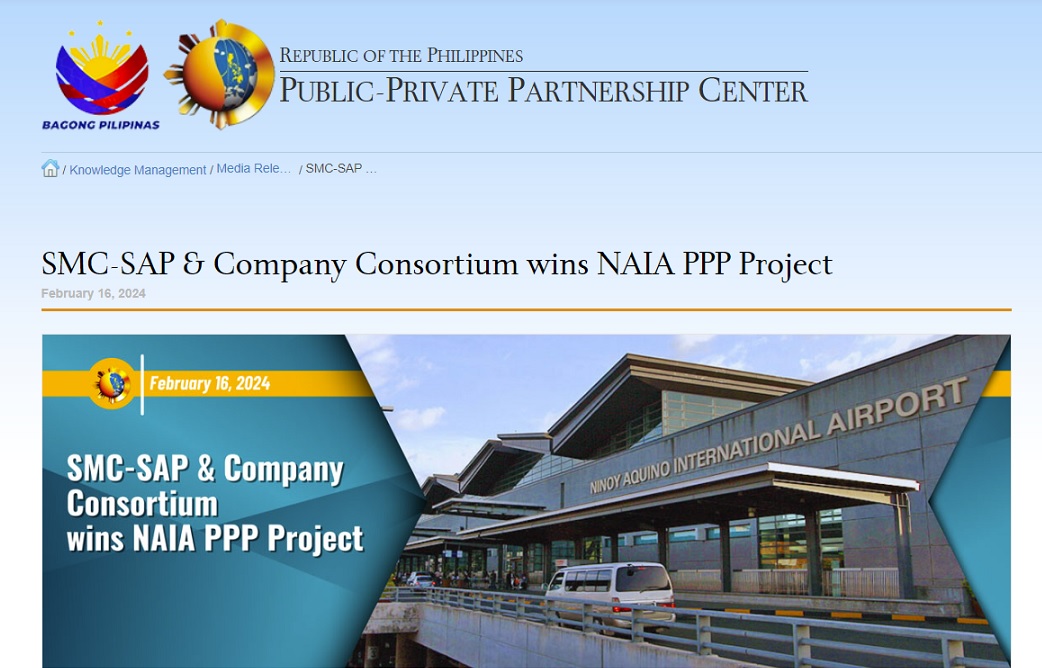The announcement of Ramon Ang’s San Miguel Corporation (SMC) winning the Php170.6-billion deal to rehabilitate the Ninoy Aquino International Airport (NAIA) did not sit well with a lot of people. Privatization it seems is a traumatic word for many Filipinos.
A few days after the announcement, passengers’ posts on being bitten by bed bugs crawling out of the airport’s chairs and on seeing rats roaming the busy terminal were trending on social media. Yet, some citizens (and netizens) have been commenting that the pest horrors are just a conspicuous gimmick to convince the public to turn over the improvement and operation of NAIA to the private sector. This is quite reminiscent of the government declaration of a national water crisis in 1995 while the deal for the privatization of water utilities was underway.
NAIA is not exactly the quality of airport we need. It is a busy airport, what with government’s labor export policy. It is operating beyond its annual capacity of 33.2 million passengers. In the past eight years, NAIA has been accommodating more passengers than it should, reaching a peak of 48 million in 2019. Passenger volume only moderated in 2020-2022 due to travel restrictions but went up again in 2023 to 45.4 million passengers on 279,953 flights. NAIA is ranked 4th among Asia’s worst airports. It definitely needs an upgrade.
But here is the pestering development: the Department of Transportation (DOTr) and SMC-SAP Consortium recently signed the contract for the NAIA rehabilitation project. The Marcos Jr administration has placed the improvement and operation of airport infrastructure and services in the hands of the private sector, at the public’s expense.
May the favorite oligarch win
During the Duterte administration, several private groups submitted unsolicited proposals for the NAIA rehabilitation. Two of these groups – the NAIA Consortium and Megawide Construction Corporation with its partner India-based GMR Infrastructure Ltd. – were even awarded Original Proponent Status (OPS). But the OPS of both groups were revoked when negotiations with the government fell through.
Now under the Marcos Jr administration, the Manila International Airport Consortium (MIAC) – formerly the NAIA Consortium minus the Manny Pangilinan-led Metro Pacific Investments Corporation (MPIC) – took another shot at the NAIA rehabilitation. It offered a Php267-billion unsolicited proposal in 2023, but the government also rejected this.
Instead, with the Asian Development Bank (ADB), the administration crafted a Php170.6-billion solicited Public-Private Partnership (PPP) project for a 15-year concession period. The National Economic and Development Authority (NEDA) Board headed by the President approved the new NAIA rehabilitation project in just six weeks – the fastest approved PPP proposal in the country’s history.
It was immediately opened to public bidding in August 2023. By January 2024, the government announced that there were four qualified bidders: MIAC, GMR Airports Consortium, Asian Airport Consortium, and SMC-SAP Consortium.
On February 16, the SMC-SAP Consortium was declared the winner after offering the highest proposed government revenue share at 82.16%, excluding the Passenger Service Charges (PSC); the next highest bid was only around a 33% revenue share.
Monopoly deals
The SMC-SAP Consortium is composed of Ramon Ang’s SMC, RMM Asian Logistics, Inc., RLW Aviation Development Inc., and Incheon International Airport Corp. But questions surround the group’s lesser known partners, RMM and RLW, even before it won the bid. Its lead member SMC, which has already bagged numerous big-ticket infrastructure projects from the government, will benefit the most from the NAIA makeover.
According to a Rappler report, RMM and RLW are allegedly being used by SMC to bypass the ownership limits for airport operators in the Greater Capital Region (GCR). Since SMC already controls the New Manila International Airport (NMIA) project in Bulacan, it was allowed only a limited stake in the project and had to be part of a consortium to qualify for the bidding. Leaked documents indicate that both RMM and RLW are relatively small companies with a paid-up capital of only Php6.3 million and both were reportedly incorporated at the same time.
RMM owner, Raymond Miller Moreno, was the former president of Liberty Telecoms, previously owned by SMC. He was charged by the US government with a number of cases including tax evasion in 1987. Little information can be found on RLW, which is reportedly owned by a certain Robert Lee Wong. Meanwhile, Incheon International Airport Corp., was charged by the South Korean government with 26 cases of tax evasion totaling US$155.8 million in 2014.
Despite the controversy, government still awarded the NAIA project to the SMC-SAP Consortium. This latest acquisition was a big win for SMC and will further strengthen the conglomerate’s monopoly of air and road transport systems in the GCR.
The controversial NMIA, otherwise known as Bulacan Aerotropolis project is slated to be the alternative airport to decongest NAIA and serve millions of passengers in the GCR. SMC also operates big tollways that include the Skyway System, Tarlac-Pangasinan-La Union Expressway (TPLEX), Southern Tagalog Arterial Road (STAR), and the South Luzon Expressway (SLEX) – all major entry and exit points to the GCR. Another toll road it operates, the NAIA Expressway (NAIAX), connects the Skyway system to NAIA’s four terminals and to the Entertainment City. SMC also manages the Autosweep RFID system.
SMC is also the concessionaire for the Metro Rail Transit 7 (MRT 7) connecting the main MRT-3 line to San Jose Del Monte, Bulacan, with an additional connecting highway from the MRT-7 SJDM station to the North Luzon Expressway (NLEX). Other slated key infrastructure projects under the SMC belt include the Manila North Harbor Port and the concession for the Boracay Airport, which is a key tourist destination.
A takeover plan
While the final concession agreement has yet to be made public, the NAIA PPP Project Information Memorandum gives an idea of the project scope and division of responsibilities between the government and the SMC-SAP Consortium, and how extensive the private corporation’s control will be of NAIA facilities and operations.
As concessionaire, the SMC-SAP Consortium will be responsible for the construction, supply, operation, maintenance, and capacity augmentation of the entire NAIA and its related facilities. Among the project’s major construction aspects, the consortium will rehabilitate the passenger terminals, associated facilities, and all the airside facilities; develop the vehicular parking lots, commercial assets, and utility systems; provide inter-terminal passenger transfer facilities and services; and connect the Metro Manila Subway station to NAIA Terminal 3.
It will ensure the supply and installation of the required information technology and other equipment for the operation and maintenance of airside and landside activities, including utility systems; supply of communications, navigation, and surveillance (CNS) systems; a remote digital tower system; an air traffic control (ATC) system upgrade; and airfield network and fiber upgrade; and provision of emergency equipment and buses for boarding transfers.
The consortium will also operate and maintain passenger terminals and related facilities as well as airside facilities; operate concessionaire O&M facilities and commercial assets; and maintain air traffic management equipment. It will ensure additional capacity augmentation which may entail enhancement of operational efficiencies, technology use, service level upgrades, and facility expansion.SMC-SAP will oversee the collection of concessionaire revenue and financing of all project activities.
So, what is left for the government? The DOTr and MIAA will mostly function as a monitoring and oversight committee for the SMC-SAP Consortium operation of NAIA. They will monitor the performance of the consortium and its compliance with airport service standards; approve the development of new assets and changes to existing assets in the terminals; and facilitate interagency coordination with all agencies involved and stakeholders in NAIA. Security and policing through the airport police will still be under government control.
Passengers’ load and peopl’s burden
The problem with privatization of public utilities like airport infrastructure is that it entails great costs that are passed on to users, in this case, the passengers, and ensure foremost huge profits for the private corporation, in this case the SMC-SAP Consortium.
The government estimates that the project will generate Php900 billion in revenue over 25 years (or if the 15-year concession is extended for another 10 years). This includes the consortium’s payment of the Php30-billion upfront premium, Php2 billion annuity payment and 82.16% revenue share to the government. This projected revenue far exceeds MIAA’s remitted dividends, which only reached Php22.05 billion over 13 years (2010-2023).
Most of these revenues will come from aeronautical charges, which was around 74% of total revenues in 2022. This includes the PSC for international and domestic passengers, landing and take-off charges, tacking fees, aircraft parking fees, cargo charges, and check-in counter charges – all of which the concessionaire can adjust during the concession period. This could result in higher airfares and other service charges for passengers.
For instance, the PSC or terminal fees, which will solely go to the consortium, account for a big chunk of total revenues (33.4% in 2022). These are likely to increase during the NAIA concession period, following in the footsteps of other PPP airport projects. For instance, the Mactan Cebu International Airport Authority (MCIAA) Board approved rate hikes at the Mactan-Cebu International Airport as part of the concession agreement with GMR Infrastructure and Megawide Construction Corp. The international PSC went up to Php750 from Php550 and domestic PSC to Php300 from Php200 in the first few years of the concession.
MIAA has already proposed possible terminal fee increases during the first year of the NAIA concession – by 95% Php390 from Php200 for domestic travelers and by 73% to Php950 from Php550 for international travelers. If the project aim of expanding airport capacity to 62 million passengers per year is achieved, this could mean billions of pesos in potential profit for the SMC-SAP Consortium that far exceeds government’s share.
Other possible revenue streams that the consortium can tap are non-aeronautical, such as the lease of land and space, parking, advertising, duty-free, and other commercial revenues. Under the concessionaire agreement, the consortium can charge their preferred market rates and capitalize on these commercial sources. With businesses in key economic sectors such as food and beverages, power companies, infrastructure development, real estate, and even packaging and financial services, this will be another opportunity for SMC to expand its profits.
One important matter to be considered is how the main entry and exit points in the country’s central economic hub are under the control of only one oligarch. With the NAIA project and the construction of NMIA, international passageways are under the control of the Ramon Ang-led SMC.This leads to major aviation security concerns for the country. Policing and other national security tasks may still be government’s role, but with the daily operations and management of the airports being under private control presents grave danger.
The rehabilitation of NAIA is long overdue. But it should not be done through privatization that will only greatly benefit the interests of a large conglomerate like SMC. Improvement and development of public utilities, infrastructure and services should be by the state and not at the expense of the people. The NAIA is essential to the daily economic activities of the country, and entrusting this to private interests will only result in growing private profits, costly services, and security threats, and not the improved welfare of the Filipinos.
IBON Foundation, Inc. is an independent development institution established in 1978 that provides research, education, publications, information work and advocacy support on socioeconomic issues.
The views in this column are those of the author and do not necessarily reflect the views of VERA Files.


